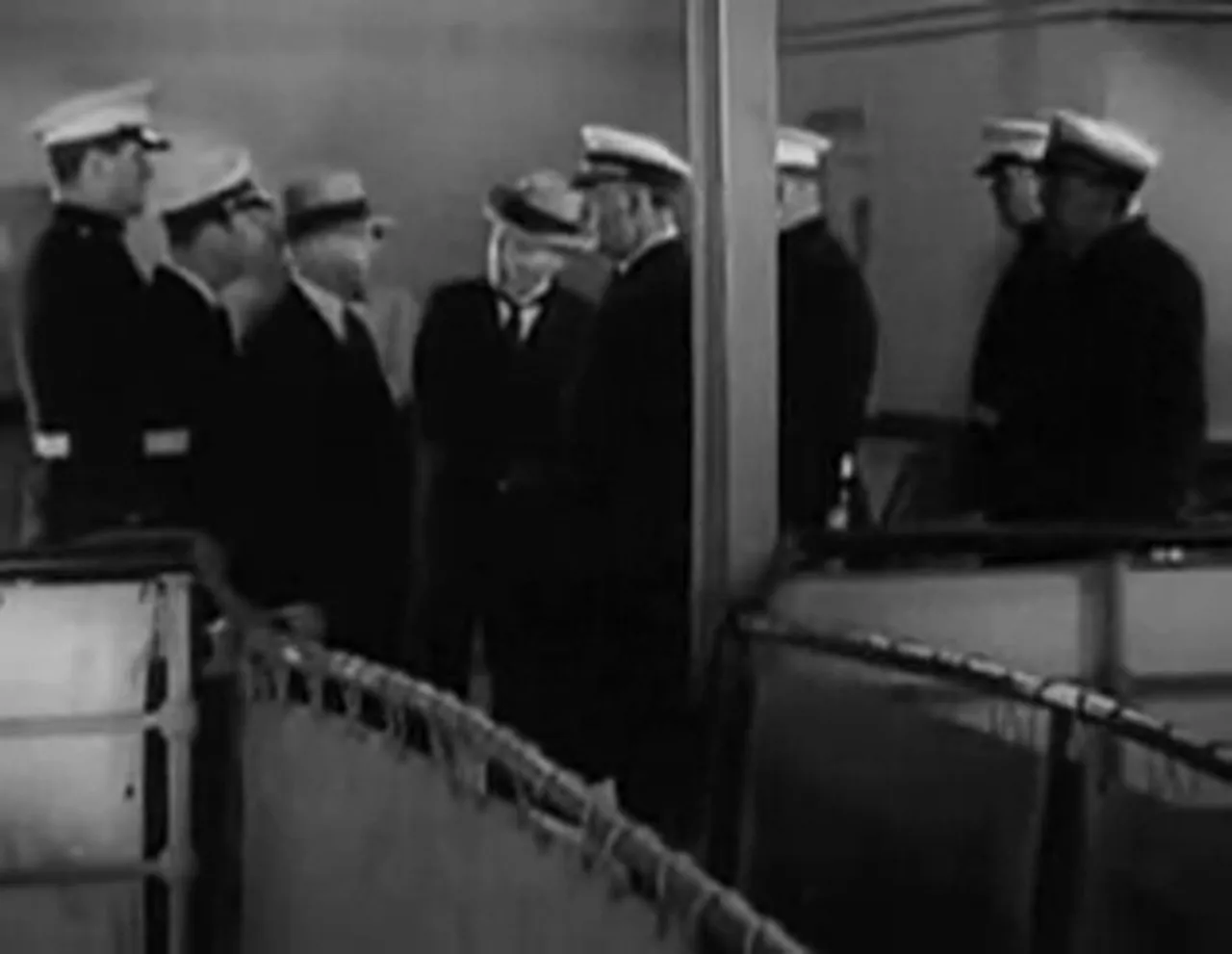The original film offers a rich, scene-by-scene walk-through that revives interest in a compact Monogram Pictures production. In this review and critical reconsideration, the film is examined through the lenses of period context, production history, narrative craftsmanship, and visual style. The critic map how Mystery Liner aligns with, and diverges from, the expectations of a film noir movie while remaining an exemplar of early-1930s B-picture ingenuity.
Outline
- Introduction and summary of approach
- Production context: Monogram Pictures, the creative team, and literary origins
- Plot overview and dramatic architecture
- Key characters and performances
- Visual and technical craft: cinematography, editing, and direction
- Themes, genre placement, and the film noir movie conversation
- Contemporary reception and legacy
- Why Mystery Liner remains essential viewing for classic cinema aficionados
- Practical viewing notes and preservation
- Conclusion and critical recommendations
Introduction: A Compact Classic in the Shadow of Noir
Mystery Liner (1934) occupies a curious place in classic cinema. An atmospheric, plot-driven picture released by Monogram Pictures, it was directed by William Nigh, with cinematography by Archie Stout and a cast led by Noah Beery, Sr. The film adapts Edgar Wallace’s short story “The Ghost of John Holling” (1924) and compresses a labyrinthine plot into a brisk 62 minutes. For viewers and critics exploring early influences on noir aesthetics and pre-Code era thrills, Mystery Liner offers fertile ground. The film’s economy, its claustrophobic shipboard setting, and recurring preoccupations with control, identity, and technological menace invite comparisons to the noir sensibility; thus it repeatedly figures in any considered conversation about a film noir movie and its antecedents.
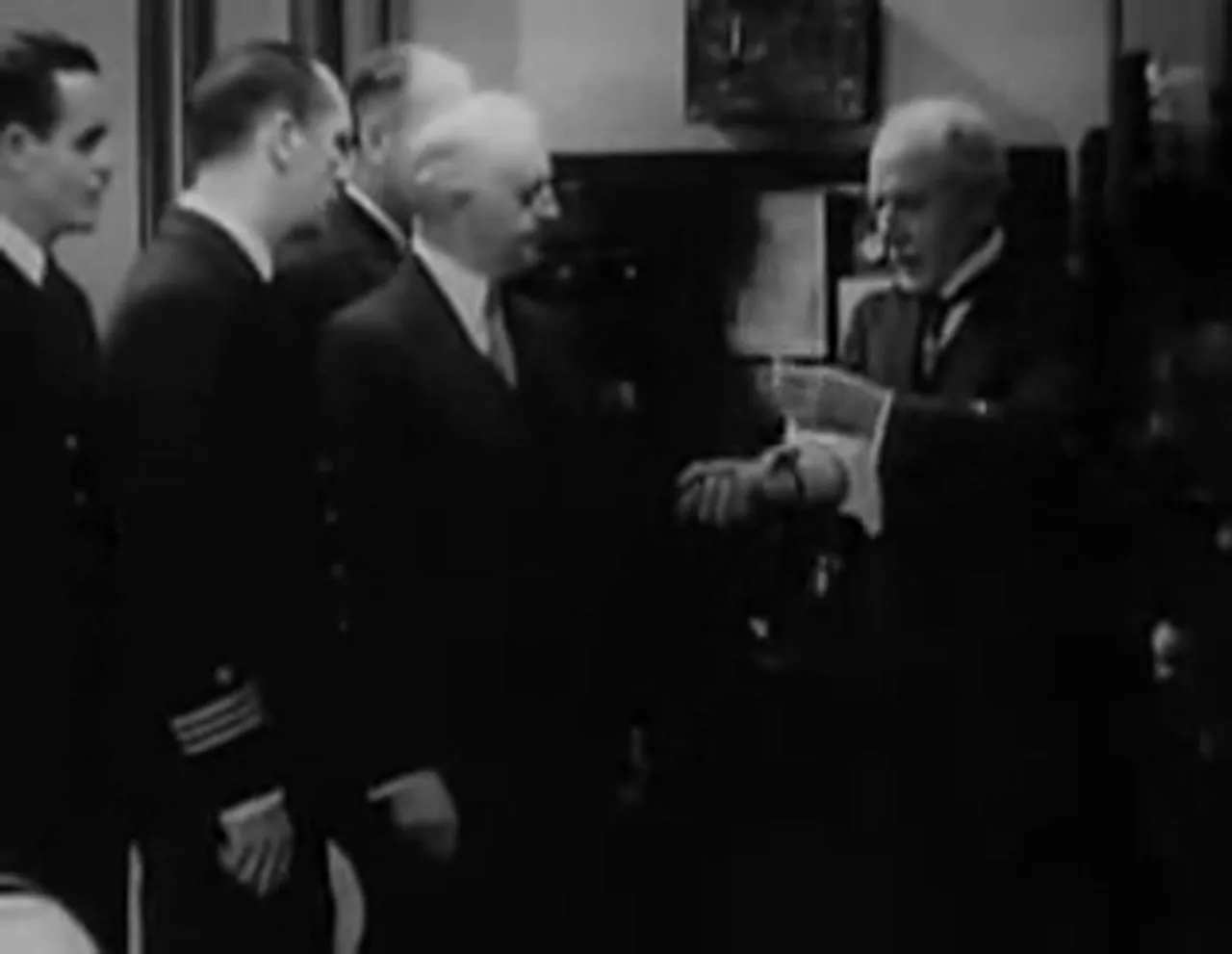
Production Context: Monogram, the Creative Team, and Literary Roots
Monogram Pictures, a Poverty Row studio, specialized in low-budget programmers. Yet this apparent limitation produced a specific brand of cinematic resourcefulness. Mystery Liner brings together a creative team capable of extracting texture from constraint. William Nigh, the director, was a seasoned professional whose career included many efficient, workmanlike thrillers. Archie Stout, the cinematographer, later gained acclaim and an Academy Award for his work on John Ford’s The Quiet Man (1952), but even here his craftsmanship elevates the material. The screenplay, credited to Wellyn Totman, is based on Edgar Wallace’s short story “The Ghost of John Holling.” Wallace’s talent for compact mysteries provided a strong structural backbone upon which the screenwriters could craft a tight, logically unfolding narrative suitable for a compact feature.
Mystery Liner was produced by Paul Malvern and edited by Carl Pierson, both contributors to the efficient studio system of the period. The film was entered as a feature attraction at the 1934 International Exhibition of Cinematographic Art in Venice, an early sign that even a modestly budgeted thriller could reach an international stage.
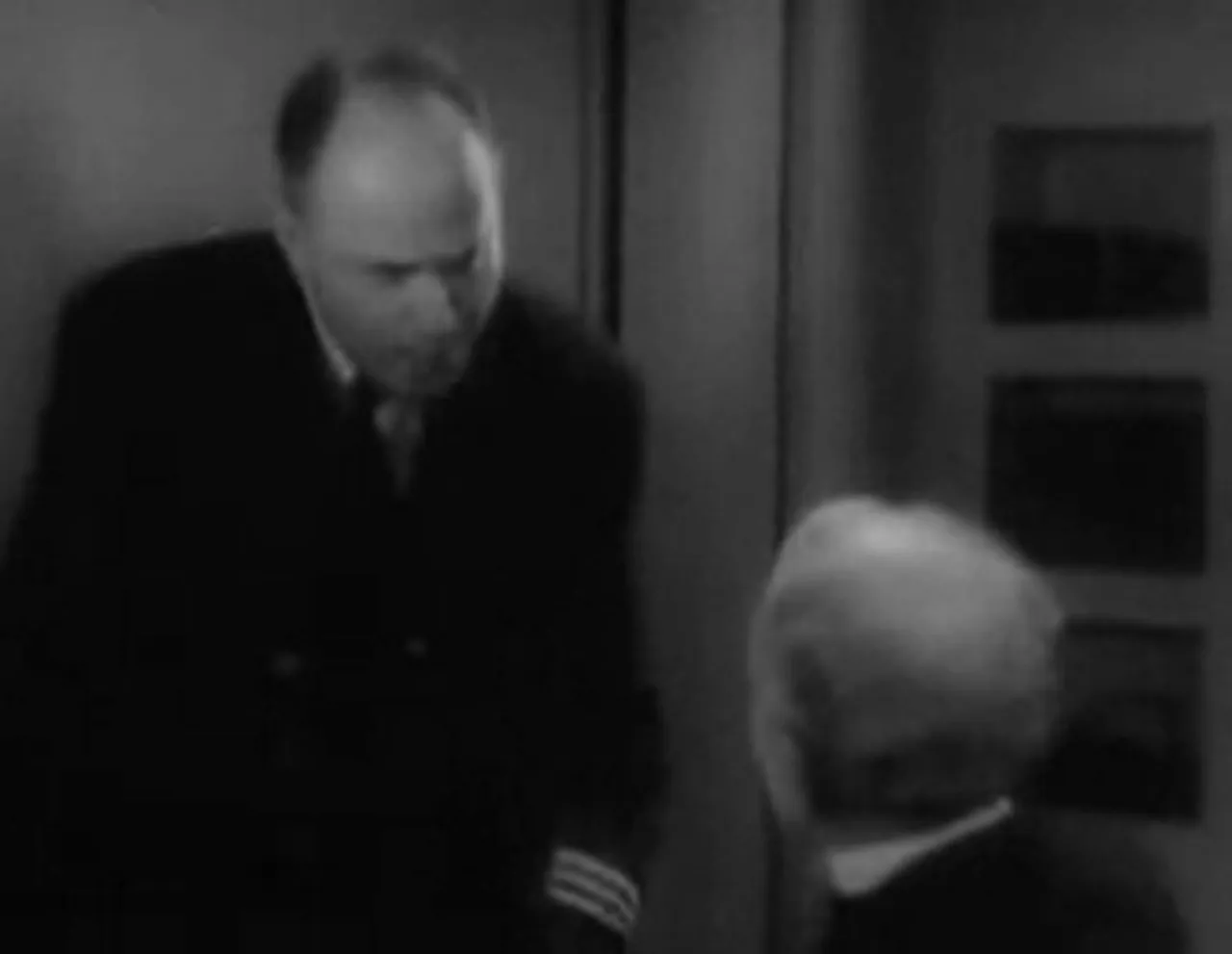
From Edgar Wallace to the Shipboard Thriller
Edgar Wallace’s original short story provided the narrative seed: a ship, a missing captain, and a supernatural or scientific explanation to draw the reader’s curiosity. The adaptation reframes Wallace’s eerie conceit as an intersection of criminal ambition and cutting-edge (for the period) science: remote radio control of a vessel. This step transforms the story into an early technothriller, where devices such as S-505 are not just plot MacGuffins but embodiments of social anxiety about modern control and depersonalization. Such anxieties would later be folded into noir films’ fatalism and distrust of institutions, making Mystery Liner a useful document for tracing the genealogy of film noir movie concerns.
Plot Overview: The Ship, the Device, and the Conspiracy
Mystery Liner’s narrative unfolds aboard the liner Guthrie. Captain John Holling (Noah Beery, Sr.) is suffering a nervous breakdown; the ship’s command passes to Captain Downey (Boothe Howard) while the ship is slated to participate in an experimental demonstration of a radio-controlled device, S-505, devised by Professor Grimson (Ralph Lewis). Grimson’s device promises to control a ship from a land-based laboratory, and such technology, if successful, could alter the balance of naval power. This premise lends the film a geopolitical dimension: not merely a closed-room whodunit, but a story of potentially world-shaping technology attracting malign interest.
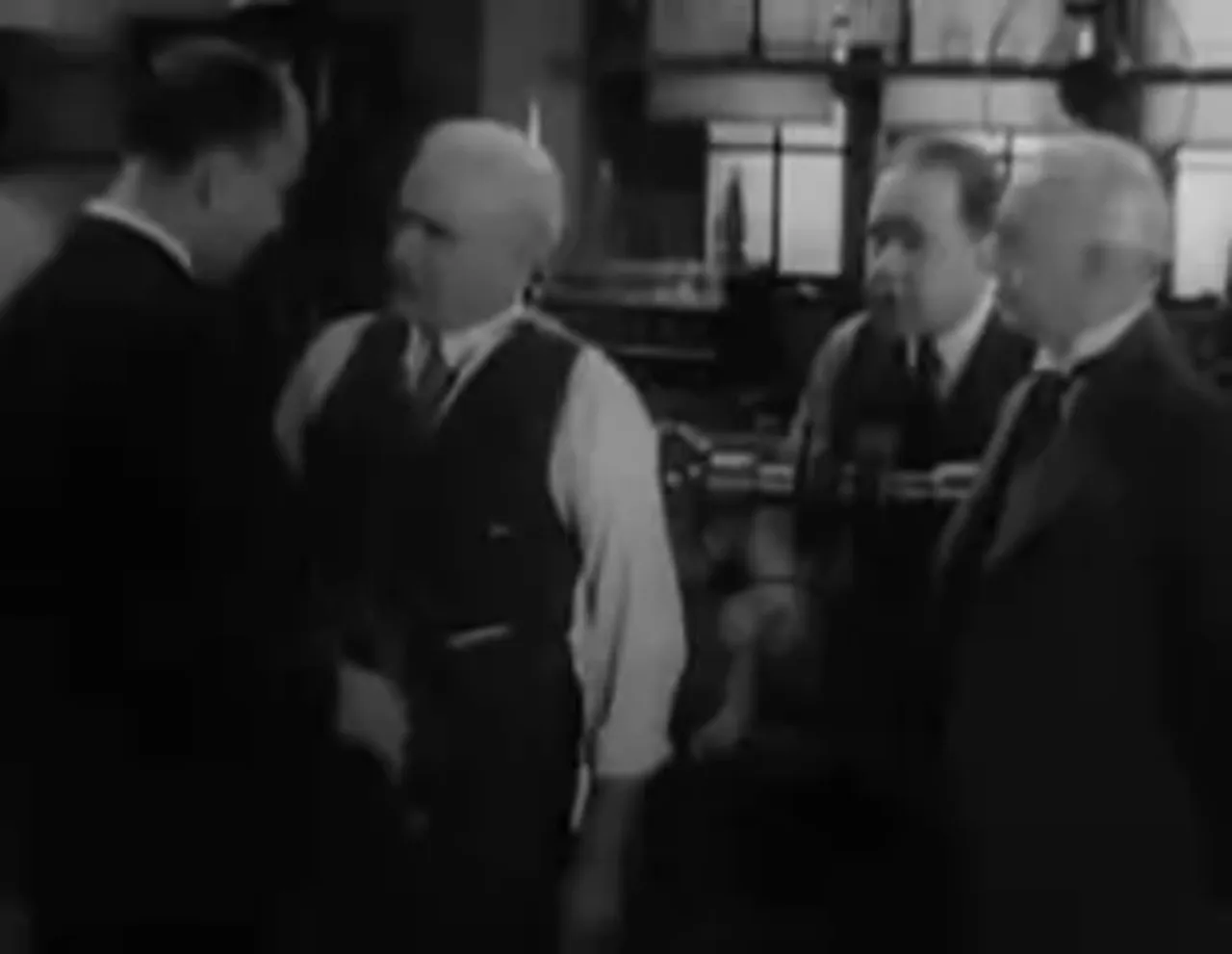
The plot interweaves two strands. The first is the murder mystery: Grimson is struck down, his neck broken, and later another man—the replacement Captain Downey—is also murdered in a similar, deliberate manner. The second is the science-and-sabotage thread: S-505’s potential success risks falling into hands that would use it for sinister ends. The possibility that Captain Holling’s escaped presence and psychological collapse might presage violence keeps the cast in a state of mutual suspicion. The film leverages a classic device: a confined setting (a liner at sea), a limited pool of suspects, and a ticking-clock experiment scheduled for nine o’clock that will test the tube and place the ship under remote control.
Act Structure and Pacing
With a running time of 62 minutes, the film must move quickly. Act One establishes Holling’s illness and removal from command, introduces Grimson and S-505, and plants the seeds of conspiracy. Act Two escalates with Grimson’s attack, the investigation by Major Pope (Edwin Maxwell), rumors of Holling’s escape, and the growing suspicion among officers and passengers. Act Three delivers the experiment, the sabotage set-piece as the ship runs under remote control, and the revelation that connects the murders to espionage and an invented secret passage within the ship’s architecture. The structure functions like clockwork: the nine o’clock demonstration is both an event and a narrative measuring point, coordinating character actions and revealing motives as tension tightens.
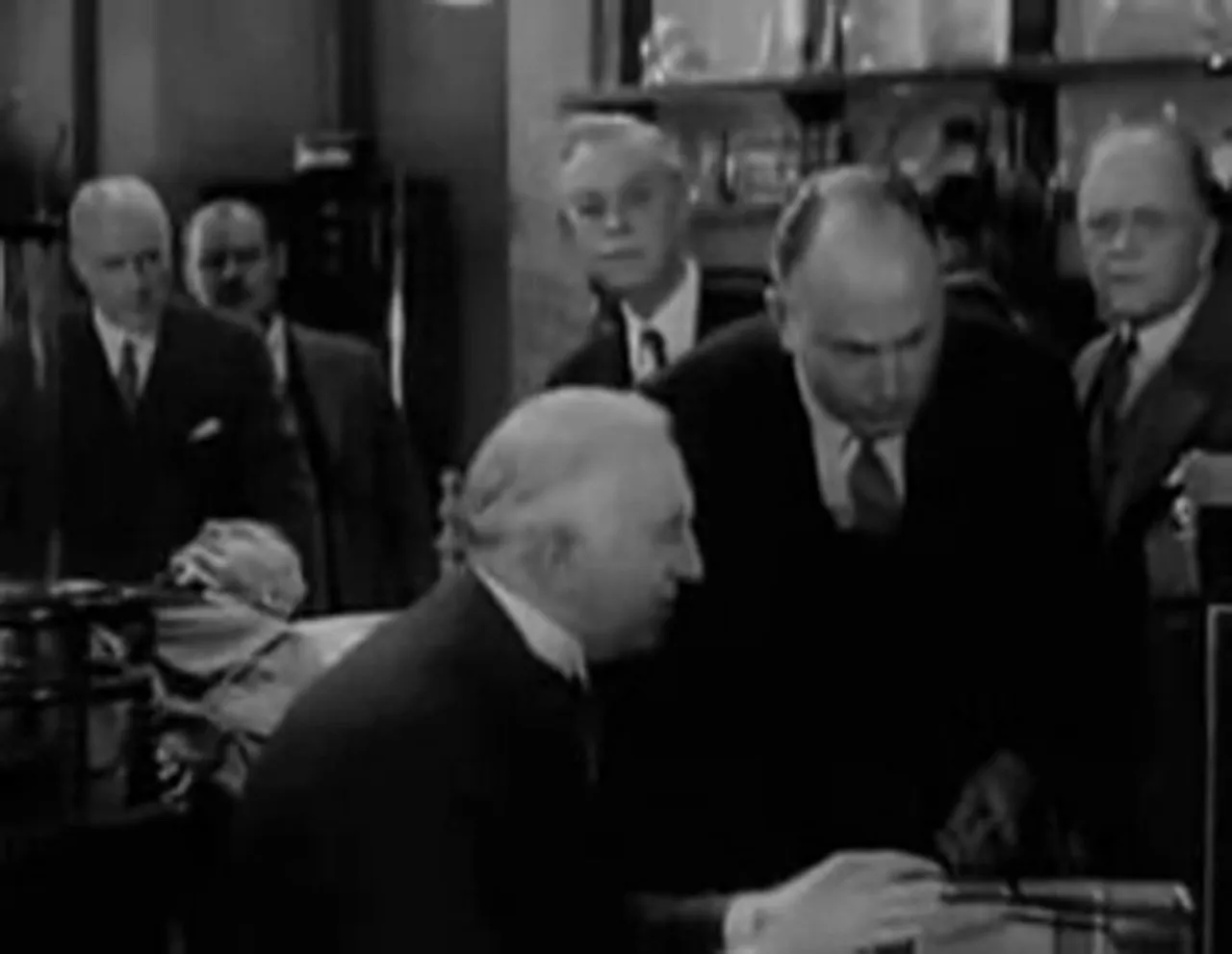
Characters and Performances: A Gallery of Motivations
Mystery Liner’s cast reflects the Monogram stable of familiar faces. Noah Beery, Sr. anchors the film as Captain John Holling, a man whose authority is undermined by mental collapse. Though Holling is physically absent for much of the film, his presence haunts the drama: he is the missing pivot, an absent authority figure who becomes both victim and, momentarily, suspect. In many scenes the crew and passengers speak of him as an almost mythic figure, lending the narrative a ghostly quality that pairs oddly but effectively with the film’s technological themes.
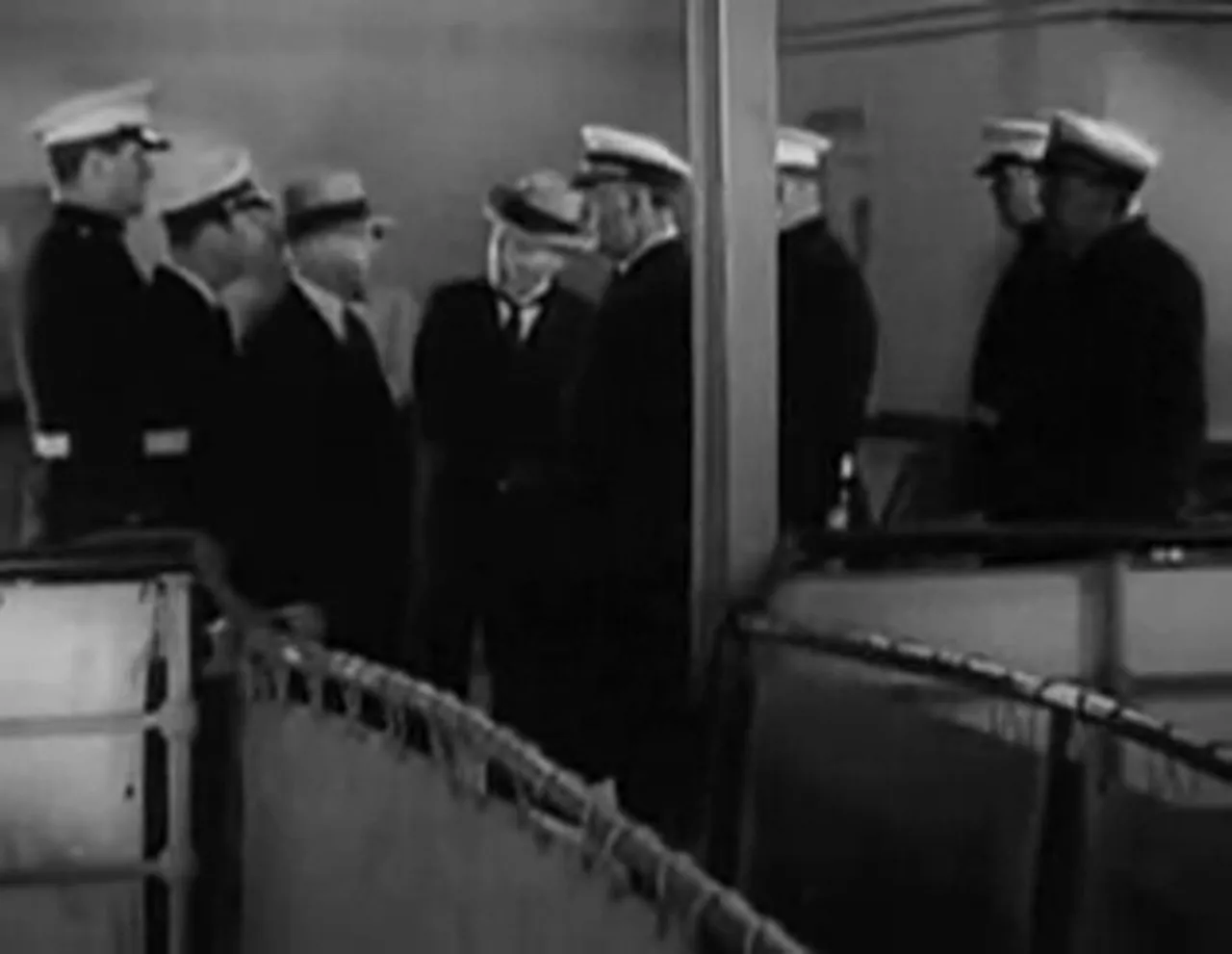
Astrid Allwyn’s Lila Kane is the film’s female lead. She is practical and resilient, tasked with supervising Holling and later serving as a fulcrum for suspicion and protection. The screenplay positions her close to the action—compassionate toward the captain but robustly skeptical when tensions rise. She is not a passive ingenue; instead, she functions as a connective tissue in the narrative, moving between the ship’s command, the hospital, and the social scenes among passengers.
Boothe Howard’s Captain Downey takes over command amid mistrust. He embodies the pragmatic officer who must steady the ship despite rumors and a spate of crimes that threaten to upend discipline. Edwin Maxwell’s Major Pope is the private investigator hired by Grimson—an early example of the penetrating detective figure who dissects motive and method in the confined setting. Gustav von Seyffertitz’s Inspector Von Kessling adds the institutional, international dimension: his presence signals that the crimes have a significance beyond the ship’s decks.
Supporting players like Zeffie Tilbury’s Granny Plimpton, Cornelius Keefe’s First Officer Cliff Rogers, and character turns from Gabby Hayes (as Joe, the watchman) and George Cleveland (as Simms the steward) furnish the ship with recognizable, vividly drawn personalities. Their brief but memorable interactions—jealousy, comic relief, and suspicion—keep the ensemble textured despite the condensed runtime.
Acting Choices and Constraints
Monogram’s actors typically had to convey character efficiently. In that mode, each performance economizes on gesture and inflection while maximizing clarity of motive. Noah Beery, Sr. brings his customary gravitas to Holling, even when the character is off-screen or disoriented. Astrid Allwyn’s clarity of delivery and the detective-like economy of Major Pope’s interrogation scenes help the audience navigate shifting alliances and suspicions. Von Seyffertitz’s measured authority anchors the film’s investigative sequences with a European gravitas that telegraphs continental intrigue.
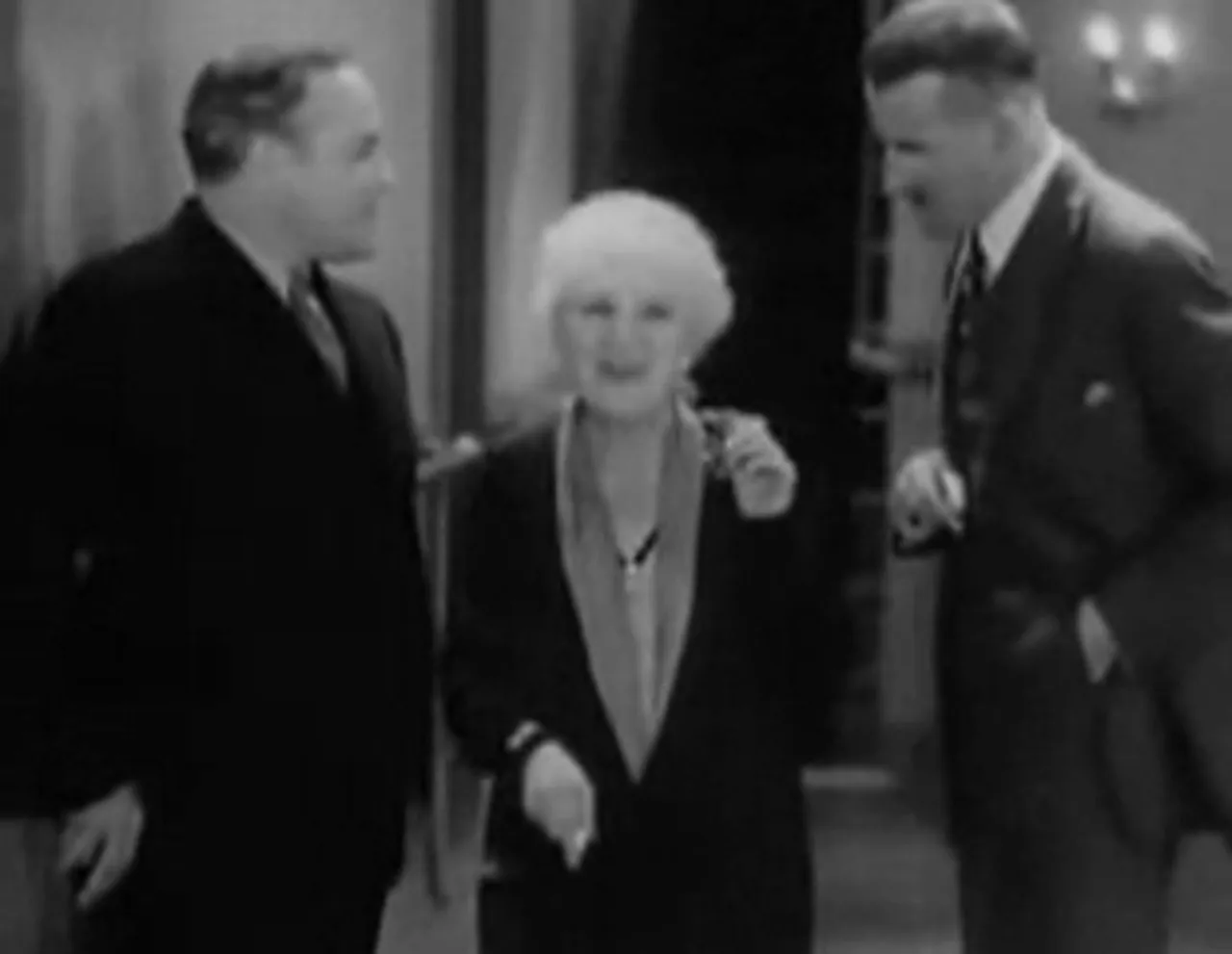
Visual and Technical Craft: Cinematography, Editing, and Direction
Archie Stout’s cinematography is one of the film’s most enduring assets. Working within the monochrome palette of early 1930s black-and-white film, Stout composes a series of sharp contrasts: the ship’s gleaming public rooms set against shadowy corridors and the forbidding interior of the control room where S-505 is kept. The camera frames create a sense of compressed space—hallways that feel longer, cabins that feel smaller, and a bridge that seems precariously perched between control and chaos. Such compositions do not merely serve suspense; they articulate the film’s thematic matrix of control and entrapment.
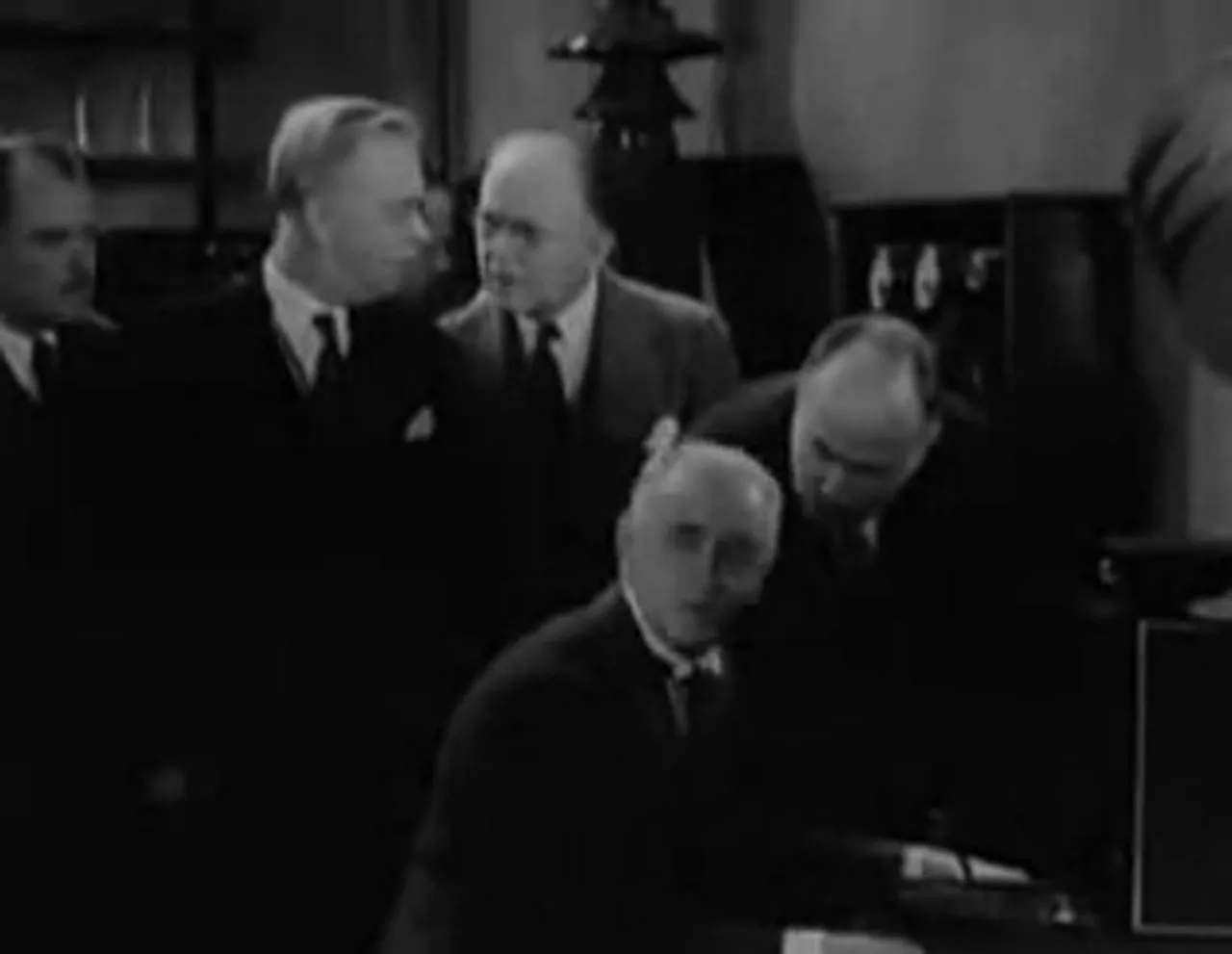
William Nigh’s direction is brisk and pragmatic. There is an awareness of rhythm—scenes are trimmed to essentials, and information is disclosed in a manner that privileges clarity over obfuscation. Editor Carl Pierson contributes to this pace: the film’s 62-minute span feels taut rather than rushed because each cut furthers either character exposition or escalating threat. Where the budget would normally limit visual spectacle, editing and performance compensate, turning suggestion into atmosphere. The constrained settings and pragmatic staging intensify the narrative’s suspense and give the film an economy that some later critics interpret as proto-noir minimalism.
Design Choices and Their Effects
Production design is serviceable but effective. The S-505 apparatus—an enigmatic glass tube central to the film’s conflict—functions as visual shorthand for modernity’s double-edged promise. Props and set dressing avoid florid excess, which paradoxically intensifies their symbolic power: sparse, clinical equipment contrasts with the warm wood and brass of the liner’s social spaces, honing a visual dichotomy between human intimacy and mechanical domination. Such design choices underscore the film’s interests in agency, dehumanization, and the moral stakes of technological control.
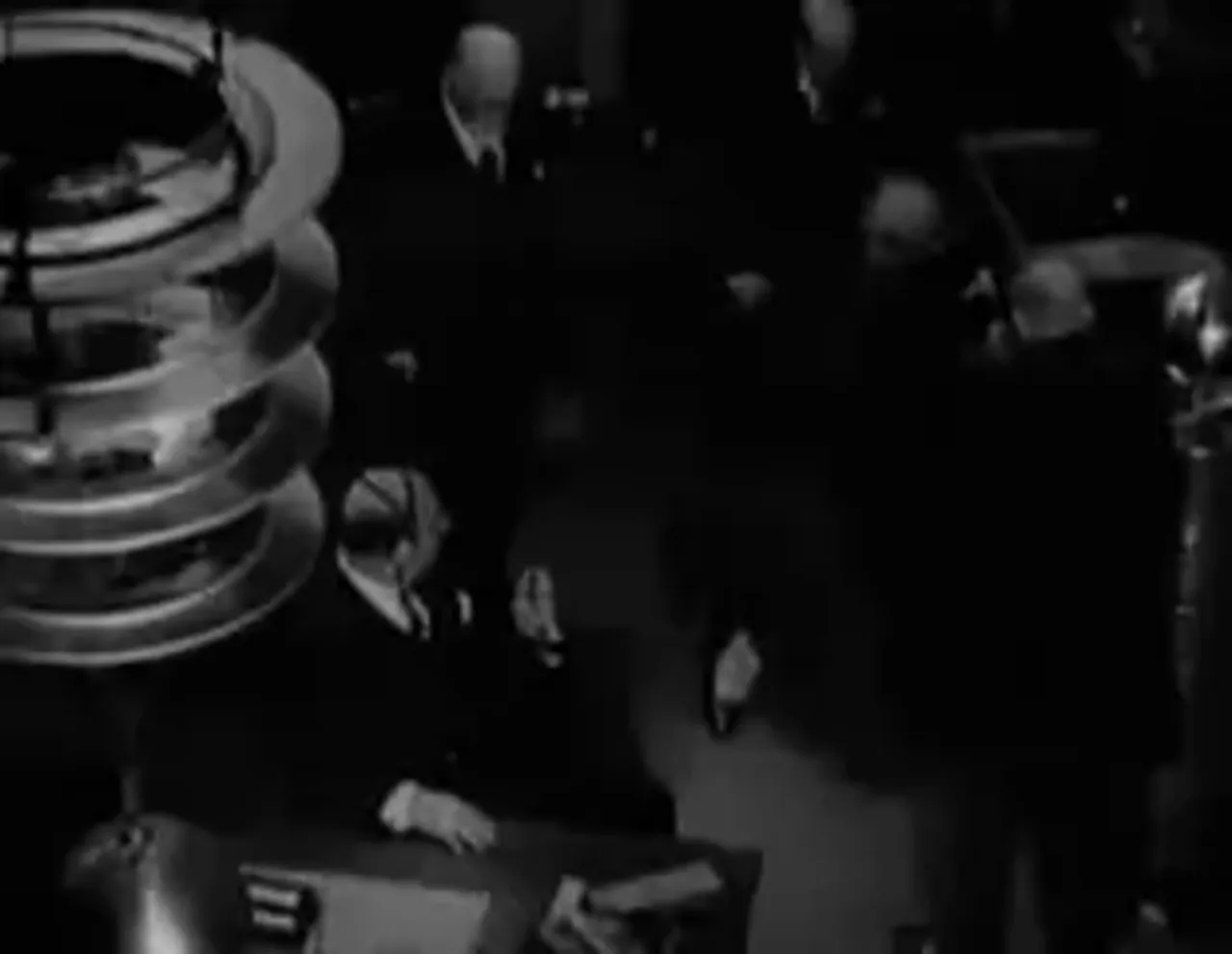
Themes, Genre Placement, and the Film Noir Movie Conversation
Mystery Liner predates the canonical period associated with film noir movie production (roughly 1940–1958), yet it shares aesthetic and thematic debts that cross-pollinate into noir sensibilities. Its preoccupations—moral ambiguity, the fragmentation of authority, the ways modern technology destabilizes human relations—anticipate motifs later codified in noir. The claustrophobic ship, the evasions of identity, and the conspiracy that threads through the passenger list all align with noir’s inclination toward fatalism, institutional critique, and observational cynicism.
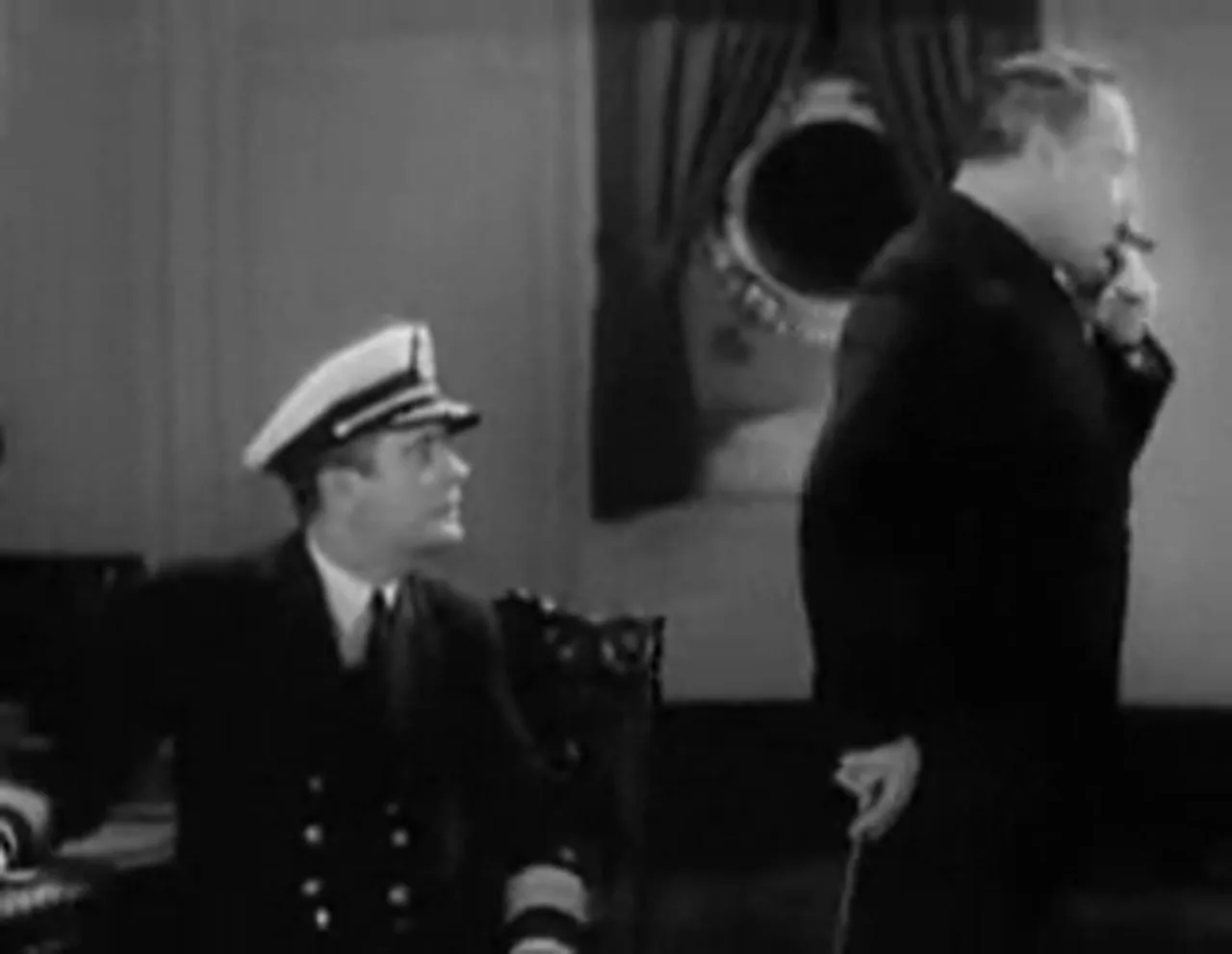
Nevertheless, it is critical to avoid a reductive classification. Mystery Liner is a product of its time: it carries the pacing, economy, and moral clarity that characterized many Pre-Code thrillers. It is an engineered thriller with an explicitly technological threat. Where film noir movies often center a morally compromised protagonist, Mystery Liner’s ensemble approach distributes culpability and victimhood across a broader field. The film, therefore, functions as both precursor and cousin to the noir lineage: it supplies stylistic precedents (lighting contrasts, urban/technological dread) and thematic antecedents (disillusionment with institutions and the erosion of personal agency) that later noir filmmakers would refine.
Technology as Villain
S-505 is the film’s central symbol: a scientific device that strips the human element from navigation, turning ships—and by extension, nations—into instruments manipulated by unseen hands. This sense of technological vulnerability is a recurrent anxiety in 20th-century cinema, and in Mystery Liner it is dramatized bluntly. The device’s successful demonstration—when the Guthrie answers remote commands, increases speed, and alters course—becomes the film’s climactic spectacle. Yet that spectacle is tinged with dread: success is not triumph but the promise of control being wrested from accountable human hands and used for unknown ends. Such a narrative move resonates with noir’s distrust of mechanized modernity and a growing sense that systems can be weaponized by avaricious, secretive forces.
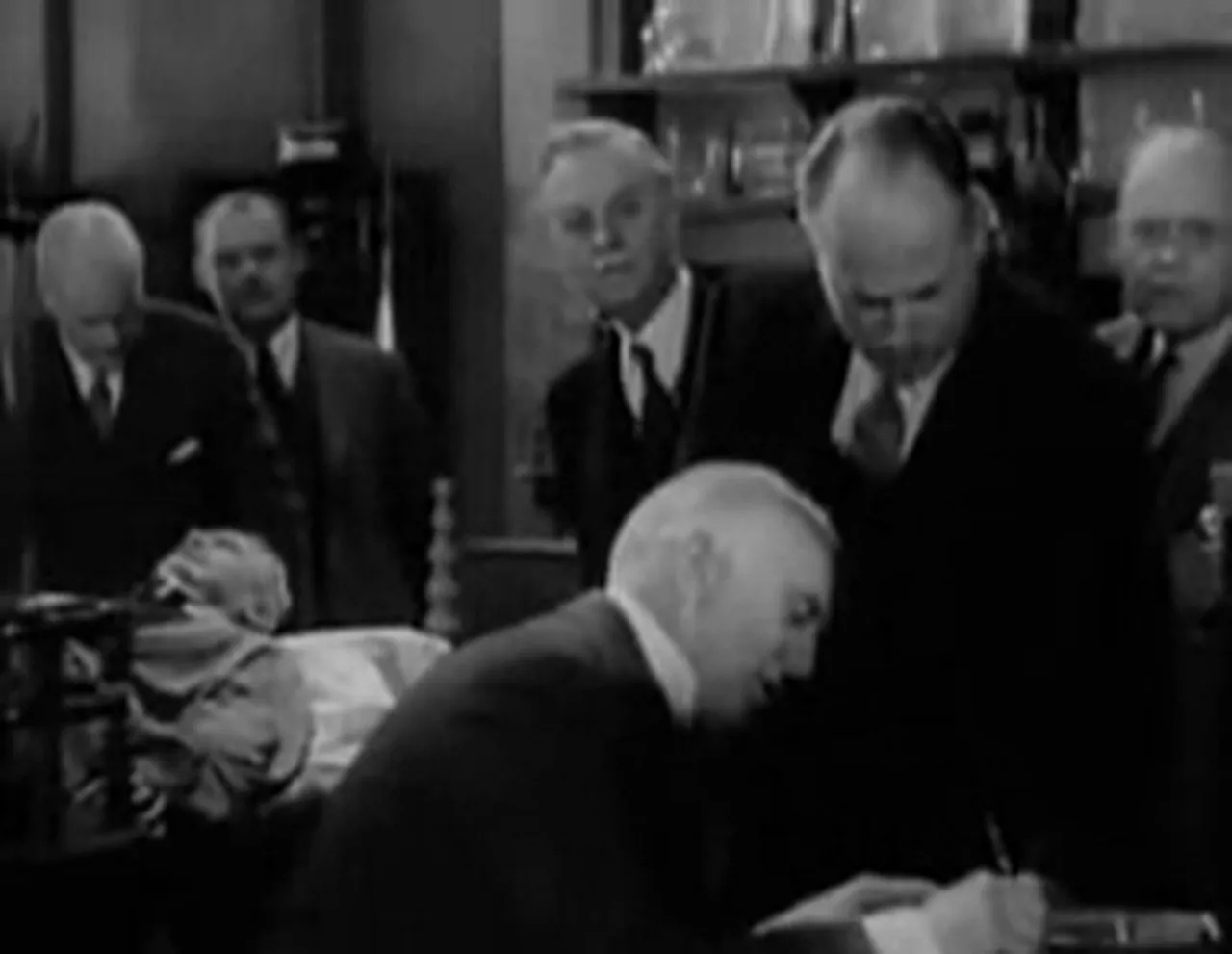
Guilt, Suspicion, and Moral Complexity
Suspicion courses through the film. Characters trade accusations, and the confined environment amplifies paranoia. These mechanics resemble noir’s narrative engine—characters whose motives are shaded, not cleanly heroic nor villainous. Major Pope’s investigations, the presence of an inspector from abroad, and revelations about secret panels and clandestine passages all contribute to the moral fog. The film’s resolution—an exposé connecting espionage networks and personal grievance—binds motive and method together in a way that feels satisfying yet morally ambivalent: justice is served, but it arrives through deception, violence, and the exposure of institutional vulnerability.
Contemporary Reception and Legacy
Mystery Liner received attention at the time of release and was later acknowledged by film historians and critics who track the evolution of genre cinema. The film’s selection for the 1934 International Exhibition of Cinematographic Art in Venice signaled that even Poverty Row fare could attract cultural prestige. Critical note has focused on its status as “intriguing but slow-paced” B-picture fare and on the quality of its photography.
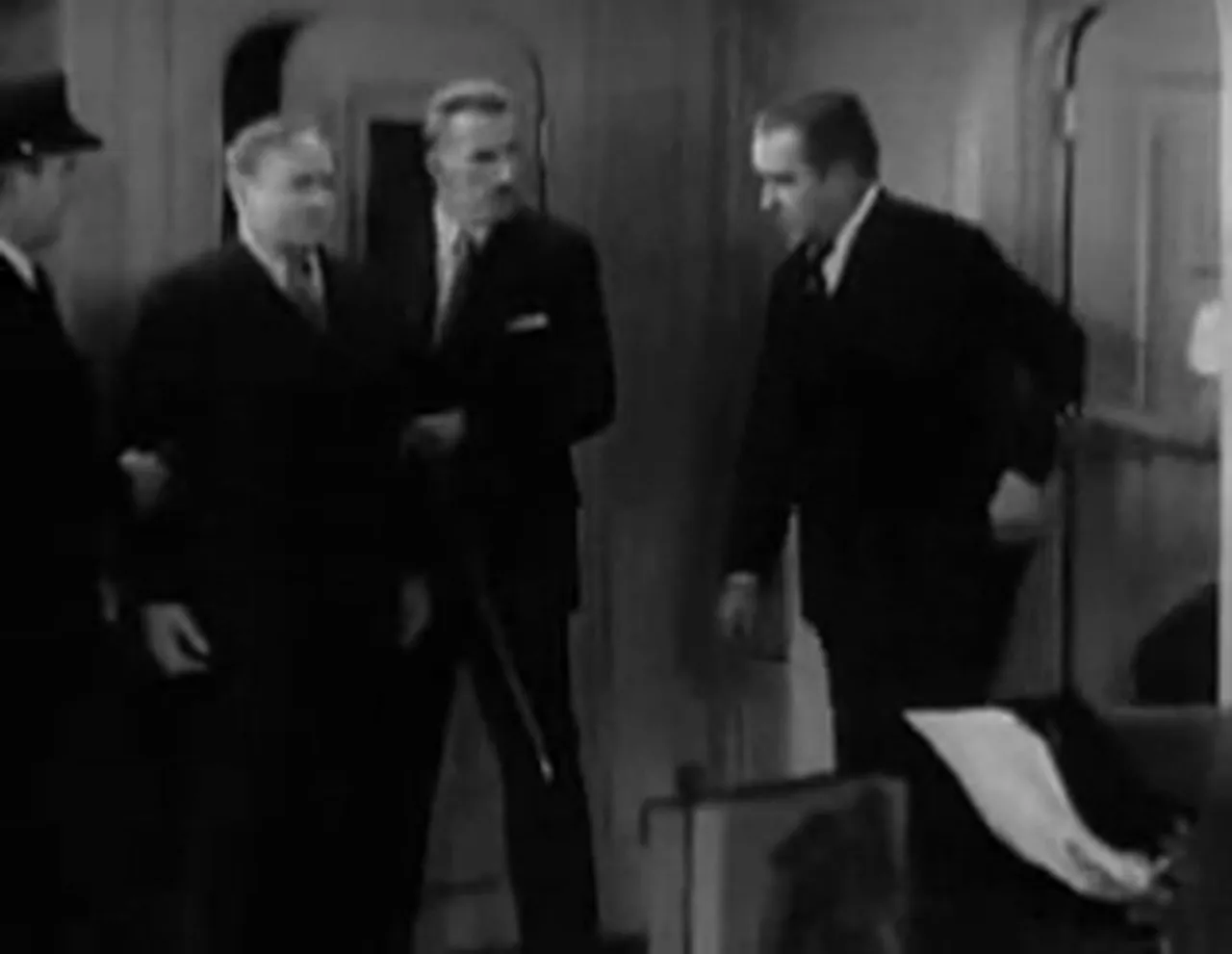
Leonard Maltin described Mystery Liner as “intriguing but slow-paced,” an apt characterization that acknowledges both the film’s engrossing premise and its sometimes leisurely exposition. AllMovie praised the film as “a rather nifty little science fiction-thriller/murder mystery from Poverty Row company Monogram,” highlighting Archie Stout’s photography and the competent acting ensemble. TV Guide similarly recognized the film as “a fine example of a well-made thriller created on the programmer assembly line,” and observed that William Nigh’s direction and Stout’s cinematography contributed exceptional camerawork despite modest resources.
Why Historians Return to Mystery Liner
Film historians and classic cinema critics return to Mystery Liner because it functions as a bridge between established mystery traditions and emergent cinematic anxieties about science, control, and identity. The film is instructive for those who study the pre-history of noir and the shaping of genre conventions. Additionally, its tight economy, compact runtime, and the clarity of its central concept (the radio-controlled ship) make it an accessible case study in how films of modest means could nevertheless produce memorable, resonant narratives. The film’s public-domain status in some territories has also permitted wider accessibility for archival study, teaching, and streaming, ensuring its circulation among cinephiles and researchers.
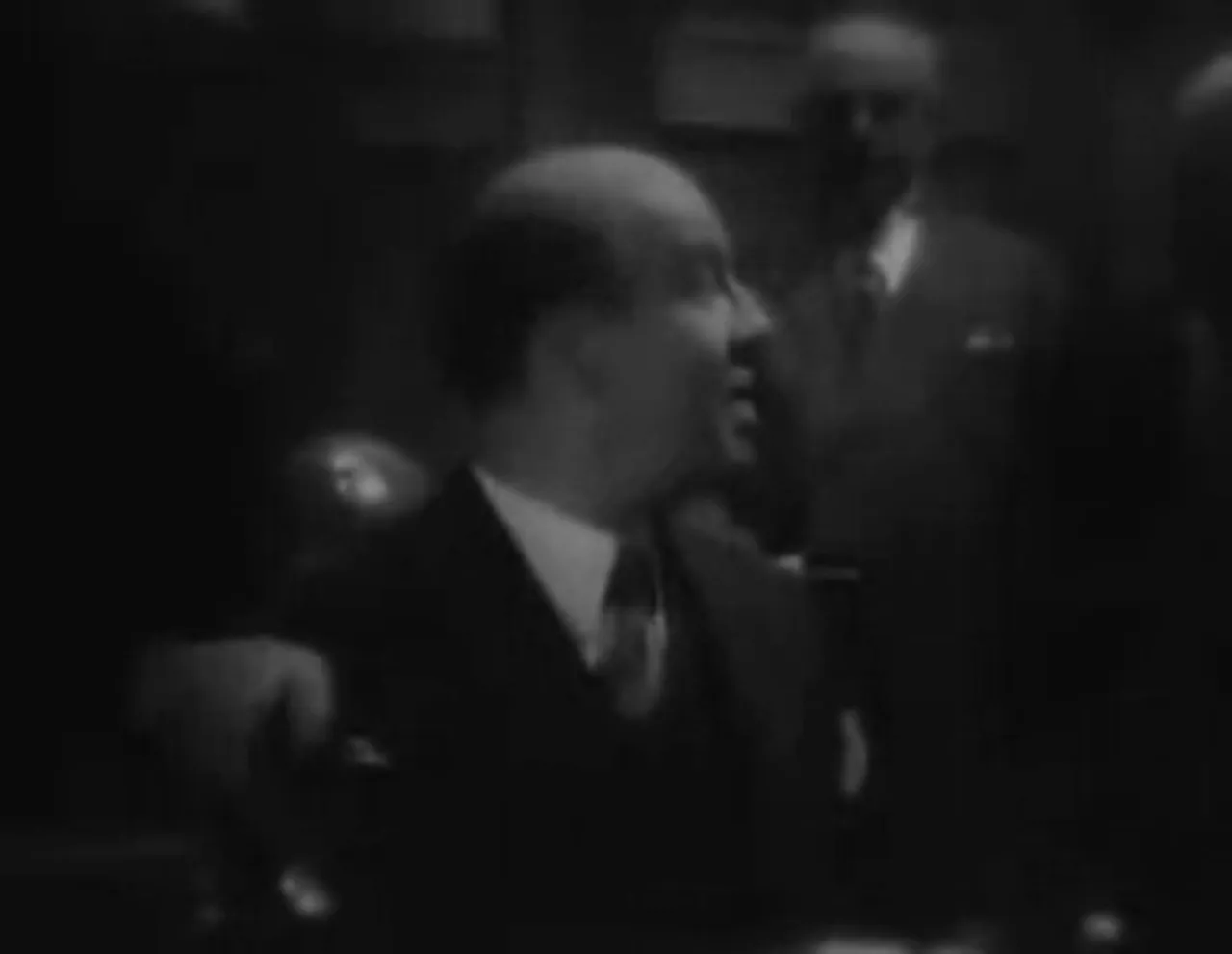
Comparative Analysis: Mystery Liner and the Film Noir Movie Tradition
When placed within a broader tapestry of classic cinema, Mystery Liner serves as a node where several lines meet: the Golden Age of detective fiction, early science fiction’s anxiety, and noir’s moral ambiguity. It is useful to compare the film against later, fuller manifestations of noir. The noir protagonists who walk shadowed streets—private eyes and femme fatales—are absent here, yet the film’s motifs of entrapment, surveillance, and the erosion of authority anticipate noir’s central concerns.
Critics might debate whether Mystery Liner qualifies as a film noir movie outright. Genre taxonomy is notoriously slippery; strict labels risk missing the continuities and cross-currents that make cinematic history legible. A more productive move is to see Mystery Liner as a formative text—an artifact in which noir’s concerns are nascent rather than fully formed. Its visual textures and moral disquiet create an aesthetic bedrock upon which later filmmakers would build.
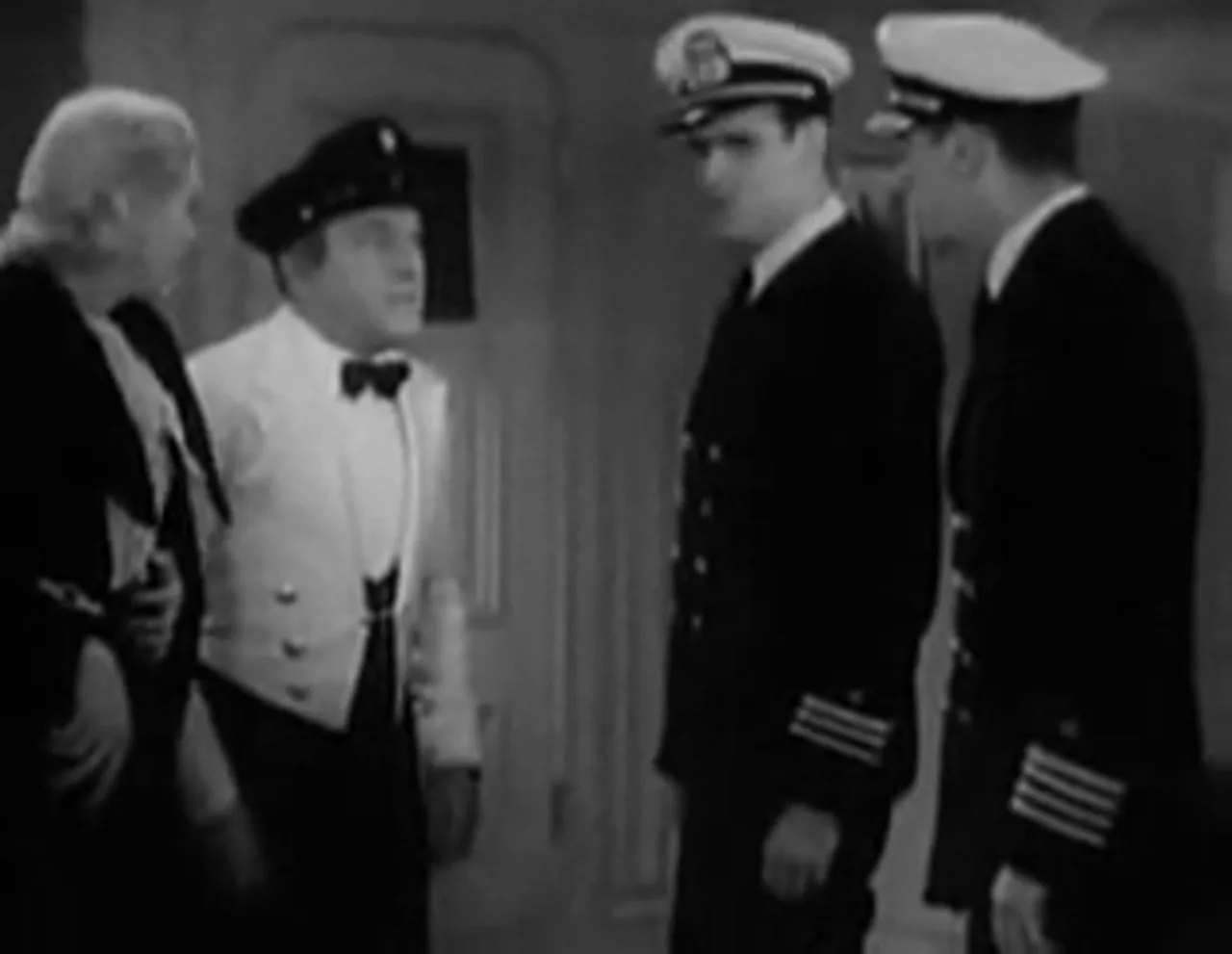
Proto-Noir Signatures
Proto-noir signatures evident in Mystery Liner include stark lighting contrasts, scenes of interrogation that probe psychological depths, and the portrayal of institutions as vulnerable to corruption or manipulation. The film also emphasizes chance, misrecognition, and secret passageways—both architectural and psychic—that echo noir’s fascination with hidden desires and concealed crimes. Whereas a canonical film noir movie may immerse viewers in cynicism and fractured narrative, Mystery Liner retains a more procedural clarity: the detective work and public explanations are foregrounded, even as the film toys with the uncanny.
Why Mystery Liner Matters to Classic Cinema Aficionados
Mystery Liner matters because it demonstrates how a low-budget studio could produce a tightly written, visually coherent thriller that engages with modern anxieties and narrative complexity. For collectors, historians, and critics, the film offers multiple points of interest: an Edgar Wallace adaptation; early articulations of remote-control fears; efficient, textured cinematography by Archie Stout; and performances from a robust ensemble including Noah Beery, Sr. and Gustav von Seyffertitz. The film’s capacity to deliver suspense within a short running time is a practical lesson in economical storytelling—a lesson that resonates for filmmakers and screenwriters studying classical narrative techniques.
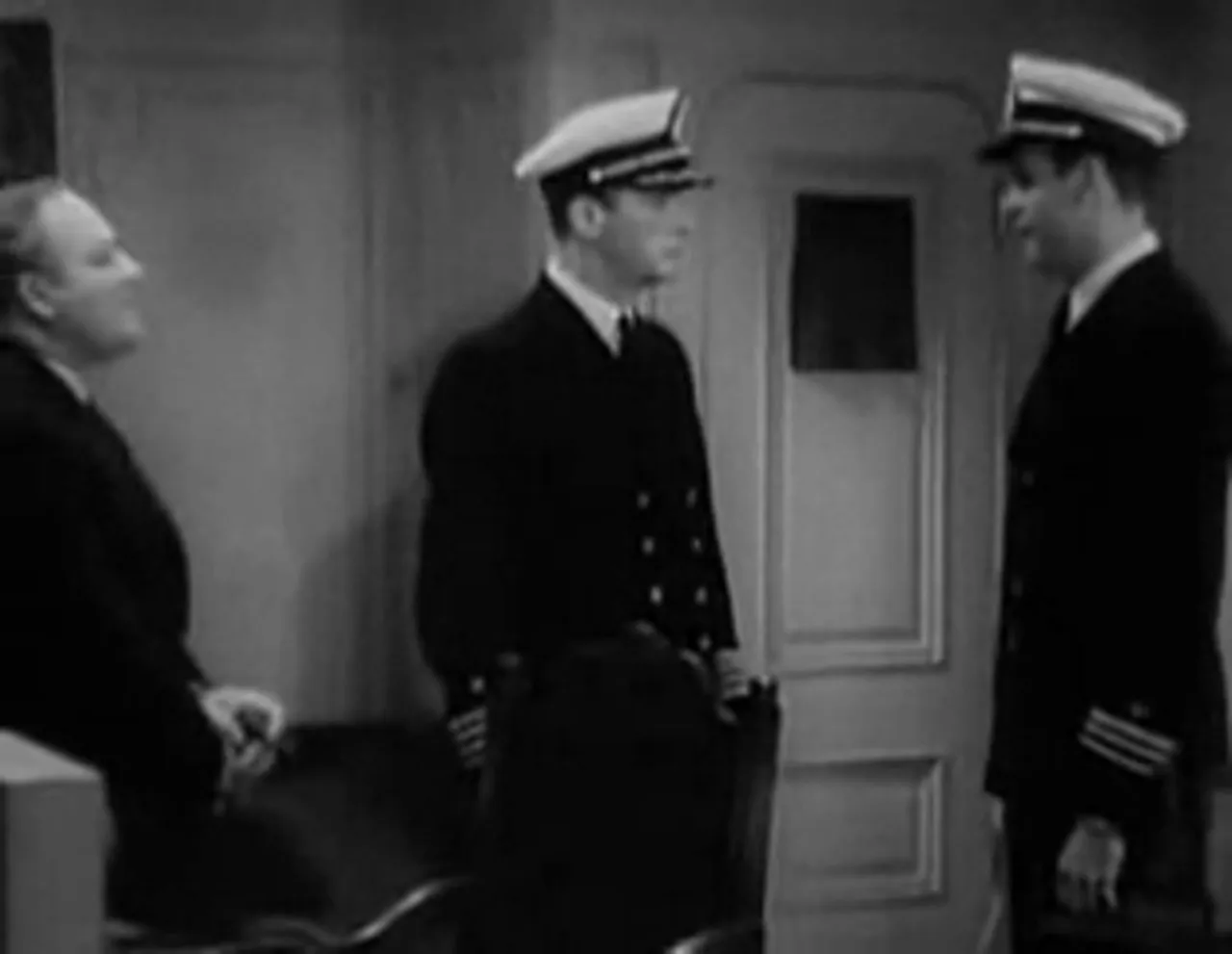
The film’s place in the lineage of a film noir movie is subtle but discernible. It represents a building block rather than a summation: a concrete example of how anxieties about modernity—its instruments, its invisible networks, and its capacity for furtive violence—manifested in early-1930s popular cinema. For those tracing noir’s genealogy, Mystery Liner is a key artifact in the pre-war cultural milieu that supplied later noir’s thematic ammunition.
Practical Viewing Notes and Preservation
Mystery Liner’s short running time and compact story make it suitable for classroom screenings or thematic programming focusing on proto-noir, Monogram Pictures, or Edgar Wallace adaptations. The film has circulated in public-domain collections and is available through archives that preserve early American cinema. Viewers who approach the film seeking high-budget spectacle may be disappointed; those who appreciate tight plotting, period atmosphere, and observant camerawork will find much to admire.
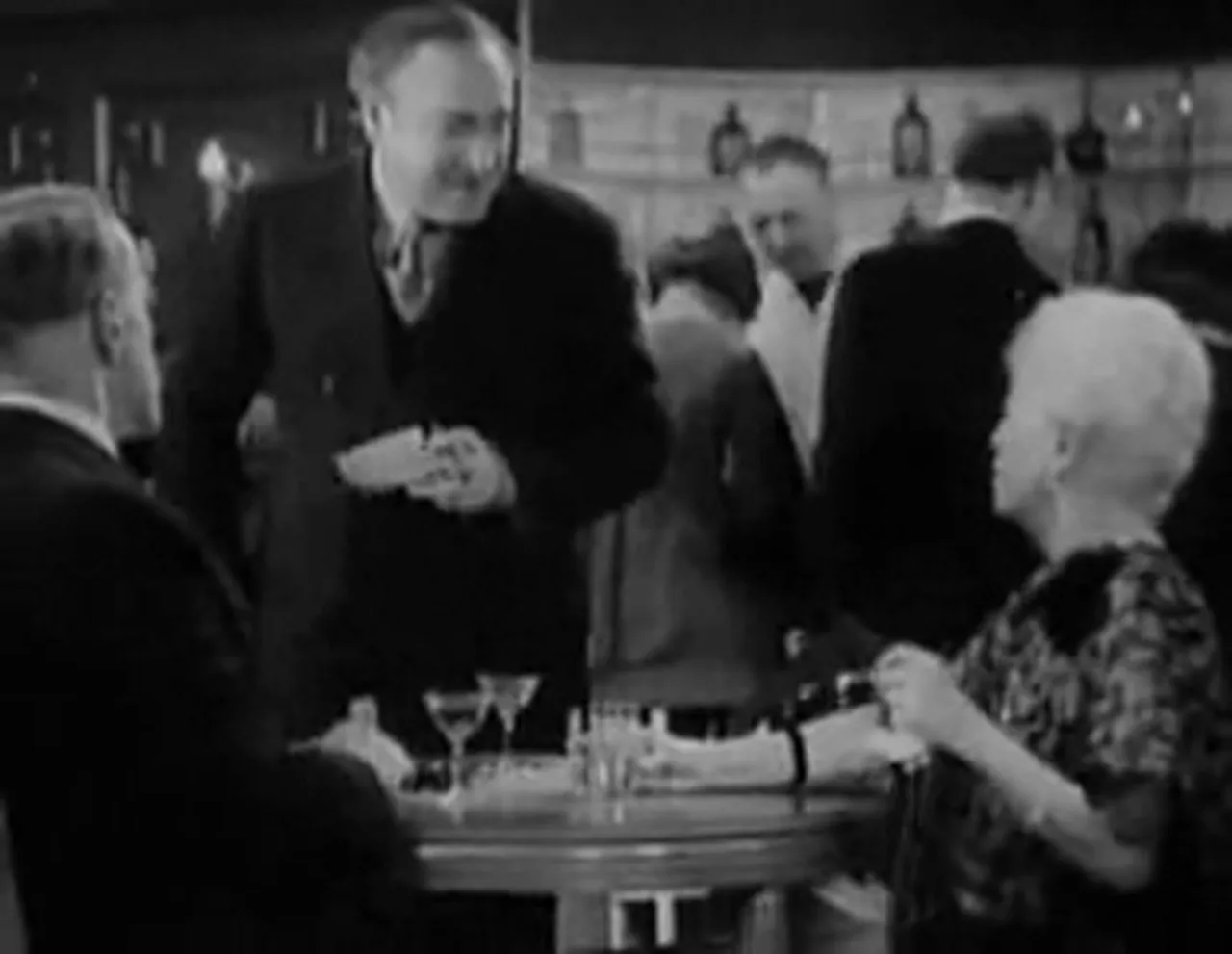
Restoration prospects for Poverty Row films have improved through digitization and archival projects. For researchers, the film offers a crisp example of Monogram’s output: resourceful, sometimes raw, and often creatively resilient. As interest in classic cinema expands across streaming platforms, even modest titles like Mystery Liner gain new life. Archivists and scholars encourage viewers to seek versions with the best available restoration to appreciate Archie Stout’s cinematography and William Nigh’s precise staging.
Conclusion: A Compact Thriller with Broader Resonance
Mystery Liner is not merely a curiosity; it is a compressed study in suspense and technological dread that anticipates many thematic elements later associated with a film noir movie. The film is both an artifact of its time and a precursor to larger cinematic conversations about agency, control, and culpability. As a production of Monogram Pictures, it demonstrates how economic constraint encouraged aesthetic decisions that sharpened rather than blunted cinematic impact. As a William Nigh-directed thriller photographed by Archie Stout, it exemplifies the craft and economy of effective B-pictures.
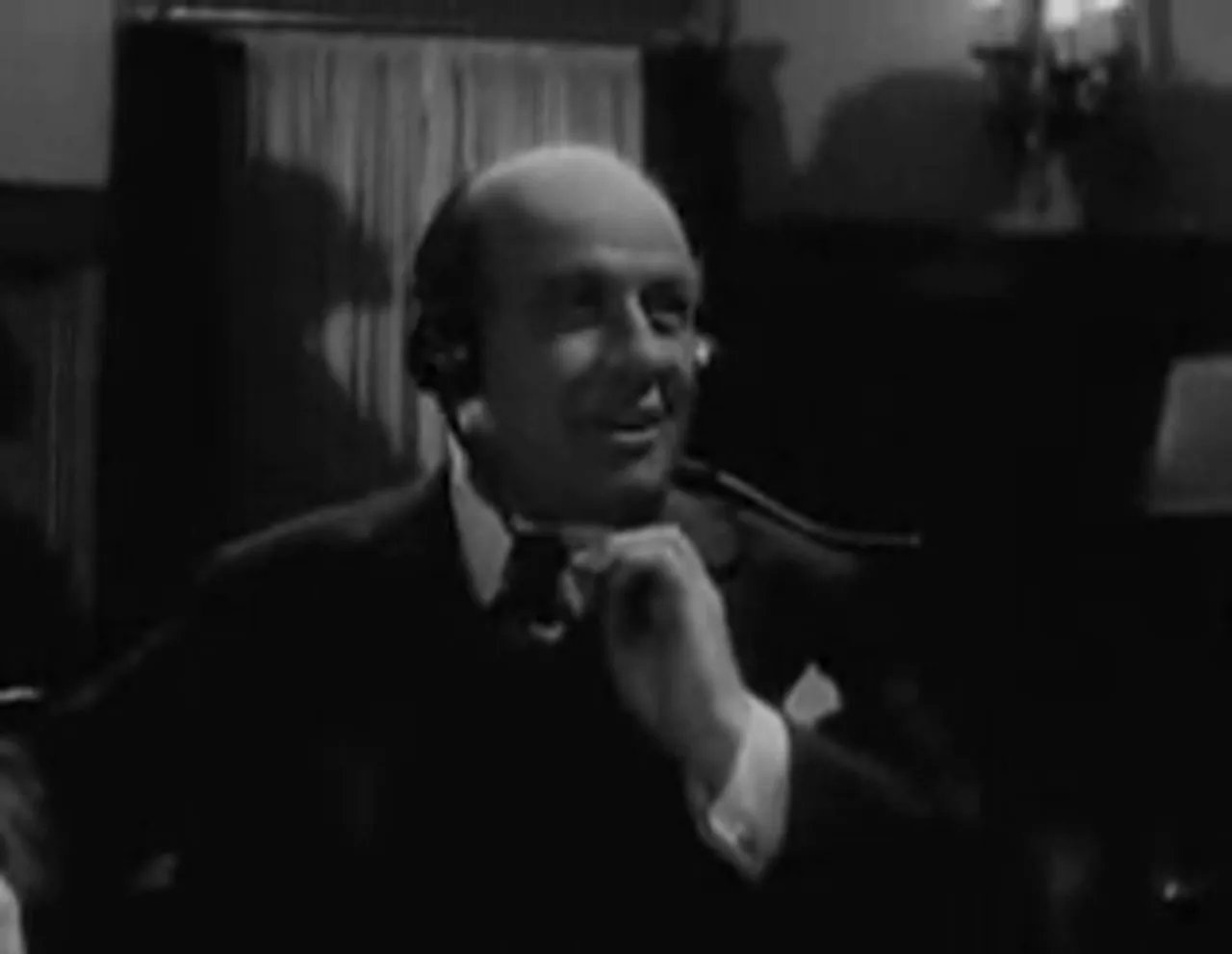
For classic cinema enthusiasts, Mystery Liner is recommended viewing. It is a brisk, staged, and thematically resonant experience that rewards attention to detail—from set design and camera angles to performance subtleties and narrative architecture. It connects to the wider discourse of noir without insisting on precise classification, offering instead a case study in how anxieties about technology and governance found early cinematic expression. Anyone exploring the roots of a film noir movie will find Mystery Liner a revealing, if unexpected, waypoint.
Further Reading and Viewing Recommendations
Readers who wish to explore adjacent works might consult other Edgar Wallace adaptations and Monogram Pictures’ catalog of crime and suspense films. To trace the visual and thematic through-lines toward noir, viewing canonical film noir movies alongside Mystery Liner clarifies how motifs and anxieties evolve: the shipboard claustrophobia, the technological threat, and the ensemble of suspicious passengers are all preoccupied with anxieties that later noir filmmakers would intensify and personalize.
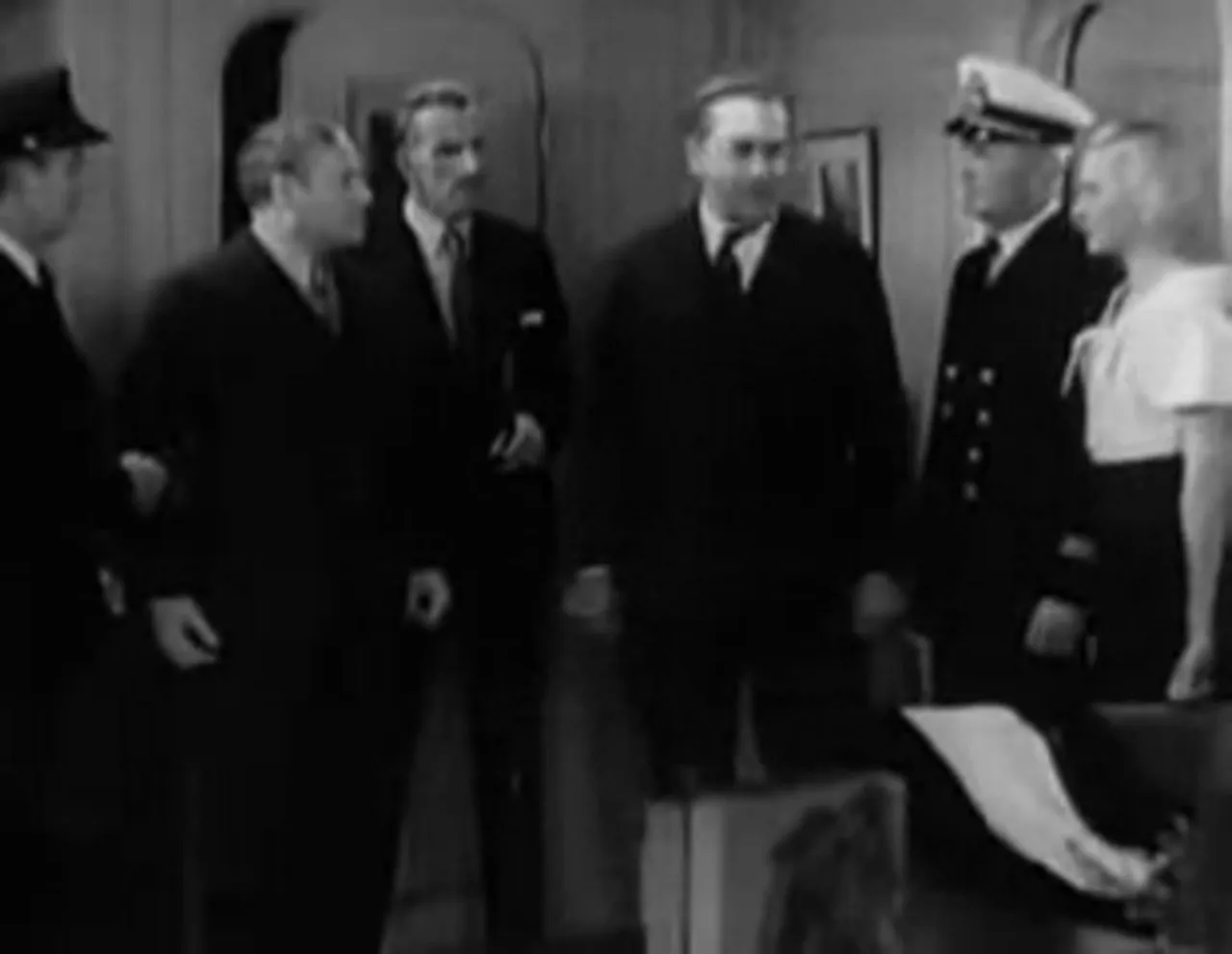
Final Notes from the Critic
This appraisal draws upon the contemporaneous record and the film’s documented production context to place Mystery Liner in a historiographic frame. It acknowledges the film’s limitations—its modest budget and occasionally uneven pacing—while emphasizing its strengths: thematic daring, strong photographic values, and a willingness to imagine technological treachery in service of suspense. For students of cinematic history and fans of early suspense, Mystery Liner provides an instructive and engaging experience and invites repeated viewings in search of subtle atmospheric details and narrative craftsmanship.
Ultimately, Mystery Liner’s compact power and speculative premise make it an essential stop on any itinerary that seeks to understand how a film noir movie’s sensibilities were gestated in the fertile soil of early-1930s melodrama, mystery, and technological anxiety. Its economy of means and clarity of concept yield a film whose influence is felt more than freely proclaimed—a quiet but telling antecedent to later noir masterpieces.
Cast and Credits — At a Glance
- Directed by: William Nigh
- Screenplay by: Wellyn Totman
- Based on: "The Ghost of John Holling" (1924 short story) by Edgar Wallace
- Produced by: Paul Malvern
- Cinematography: Archie Stout
- Edited by: Carl Pierson
- Production company: Monogram Pictures
- Distributed by: Monogram Pictures
- Release date: March 15, 1934 (U.S.)
- Running time: 62 minutes
- Country: United States
- Language: English
Principal cast includes Noah Beery as Captain John Holling, Astrid Allwyn as Lila Kane, Edwin Maxwell as Major Pope, Gustav von Seyffertitz as Inspector Von Kessling, Ralph Lewis as Professor Grimson, Cornelius Keefe as First Officer Cliff Rogers, Zeffie Tilbury as Granny Plimpton, Boothe Howard as Captain Downey, Howard C. Hickman as Dr. Howard, Gabby Hayes as Joe the watchman, and George Cleveland as Simms the steward.
Recommended Viewing Experience
- Watch with attention to how the ship’s architecture—hallways, cabins, and the control room—creates narrative pressure.
- Note the camera’s use of negative space and contrast during interrogation scenes.
- Observe how sound (or the lack of it in S-505 sequences) increases unease—modern technology translates into silence that is itself threatening.
- Compare the film’s technological anxieties to later noir films’ institutional and moral anxieties.
- Revisit select scenes after consulting Edgar Wallace’s original story to see how the adaptation reframes supernatural suggestion into scientific menace.
The critic’s closing recommendation: view Mystery Liner with an eye to both its historical specificity and its anticipatory gestures toward later cinematic currents. The viewing reward lies in witnessing how a compact, carefully wrought B-picture articulates some of the deepest cultural anxieties of its age while still delivering the pleasures of a well-made suspense story. For those curious to trace back the antecedents of a film noir movie, Mystery Liner offers a satisfying and illuminating detour.
